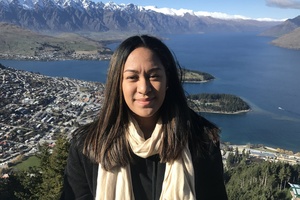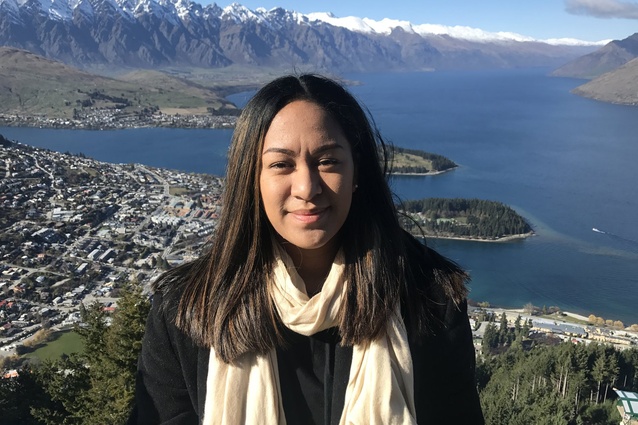In practice: Te Aranga Design Principles
Landscape Architecture Aotearoa asked landscape architect graduate Jacqueline Paul (Ngāti Kahungunu, Ngāpuhi, Ngāti Tūwharetoa), and landscape architect William Hatton (Ngāti Kahungunu, Rongomaiwahine, Rangitāne, Ngāti Raukawa, Muaūpoko) to provide an insight into how the principles are implemented in practice, and the potential for them to transform planning and policies processes.
Te Aranga Māori Design Principles were developed by Māori design professionals as a response to the New Zealand Urban Design Protocol in 2005. Over time the principles have eveolved and been adopted by the Auckland Council with the support of Ngā Aho and are being promoted across all council built projects.
Māku anō e hanga tōku nei whare, And I will build my house.
Ko ngā poupou he māhoe, he patatē, And the pillars will be made of māhoe and patetē.
Ko te tāhuhu he hīnau. The ridge beam of hīnau.
Me whakatupu ki te hua o te rengarenga, It shall blossom like that of the rengarenga,
whakapakari ki te hua o te kawariki. And be strong and flourish like the kawariki
This tongi of King Tawhiao (the second Māori King) reflects his vision of a unified collective, nurturing and flourishing together, bringing the skills, expertise and experiences of all people. These wise words are reflective within the Te Aranga Strategy, which is a cultural landscape approach to design thinking and making, incorporating a series of Māori cultural values and beliefs between iwi Māori and iwi Tiriti.
The Te Aranga Design Principles (TADP), which have evolved from this strategy, address the processes of economic, social, environmental and spatial development changes. They are a set of outcome-based principles founded on Māori cultural values and formulated to provide practical guidance for enhancing outcomes for the design environment.
The core values of rangatiratanga, kaitaiakitanga, manaakitanga, wairuatanga, kotahitanga, whanaungatanga and mātauranga are important to understand as it is the way of engaging and collaborating within Te Ao Māori (the Māori world) and within Te Ao Hurihuri (the changing world).
For Māori, these values not only represent their own personal and collective beliefs and values, but they provide a means of asserting identity of self and place, enhancing the overall presence, visibility and participation of mana whenua in the design of the physical realm. This enables the development community to understand how all can positively engage with mana whenua to shape our natural and built environment.
Any development where cultural values are significant should be embedded within an urban design framework that underpins and responds to tangata whenua values. This can be well anticipated but also very difficult to integrate within the practice and design processes.

As a landscape architect at Boffa Miskell, William Hatton believes the TADP has the means of empowering and provoking change within the physical and design environments. Not only are they principles founded on the basis of whanau, but they also give Māori a voice in the overall decision making of there place.
“With more than 88 per cent of Māori now living in urban areas, it is important to acknowledge and provide mana whenua with a presence within the places they live and breathe. It is also as important to recognise mātāwaka (Māori not local to the area they live) and non-Māori presence too; after all, it is a two-way process. With many disconnected from their whanau and own sense of place, the environment must cater to all factors,” Hatton says.
“Design, planning and policy therefore are all equally important. Working in the professional design environment has given me the opportunity to work with manawhenua, mātāwaka and non-Māori alike, but has also given me the opportunity to be a voice for Māori and non-Māori within the design environment. Collaborating and empowering one another is vital in terms of whanau and community.”
Although there are many challenges and struggles amongst varying iwi and hapū (tribes and sub-tribes), councils and government, the TADP provides a tool in which Māori understand in terms of values and beliefs, therefore providing a platform for decision making and representation at the table. Appreciating each other’s values and beliefs is crucial for a healthy living environment.
Māori researcher Jacqueline Paul is working with the National Science Challenge: Building Better Homes, Towns and Cities, a collective made up of institutional and independent researchers who partner with industry, iwi, communities and government – both local and central – to deliver robust research evidence. The research will identify new ways of living that reflect New Zealand’s unique identity and respond to our changing lifestyle needs and aspirations.

This will improve future urban environments; for example, local government, developers, iwi, and the community can implement practices known to be successful, as evidenced by the research. Also, it will inform better planning practices and land use decision-making about the structure of successful communities. (National Science Challenge: Building Better Homes, Towns and Cities 2018)
“Working within the research space from a landscape architecture background has been significant in developing a better understanding of the potential that Te Aranga Design principles have to build better communities and cities. We need to take a holistic and values-based approach to policies, planning and practice to inform more culturally appropriate and authentic design practices,” Paul says.
From a professional perspective, various design practitioners were consulted about the Te Aranga Design Principles and the important role they play in informing better design outcomes and influencing engagement strategies within the design environment.
Rachel De Lambert, a landscape architect and partner at Boffa Miskell shares her views on the TADP. She says, “This is going to be a challenge for a lot of the iwi that are in post-settlement stages; a lot of sectors focus on development and don’t necessarily take a cultural, values-based approach. I think that’s an interesting challenge. If Māori were leading with a different way of thinking about how we deliver better outcomes, then that would help to normalise the idea that there is a much better way to do things. If we are thinking about the longevity of the planet or the lives we are leaving behind for our grandchildren, then we need to start taking a different approach.”
Julia Wick, specialist landscape architect at Auckland Council shares her understanding and experiences engaging and implementing the Te Aranga Design Principles within Auckland Council’s Design Office:
“I learnt more about the embodiment of Te Aranga Design Principles when I started talking to people like Phil Wihongi. It is people with that knowledge that you end up working with somehow, and then you realise it’s not actually a tick list of things we’re trying to achieve, it is the fundamental philosophy of how you do things.”
These statements are important because practitioners play a vital role in embedding the Te Aranga Design Principles within practices, processes and design outcomes. The principles don’t only provide practical guidance for enhancing outcomes for the design environment, but create a shift in the thinking of practitioners to better understand how all can positively engage with mana whenua and iwi Māori.
What we can learn and question from the TADP is the importance our roles have for both the environment and wider community. Therefore, what is our role as landscape architects within this space?
How can we unite as an industry to support our wider communities and the protection of our cultural landscapes to ensure they are sustained for future generations?
A version of this article first appeared on the Landscape Architecture Aotearoa website, which is published by the New Zealand Institute of Landscape Architects (NZILA).












